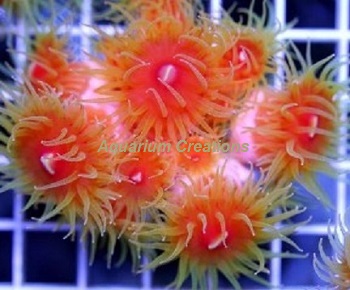Fathead Dendros, Dendrophyllia fistula, are a non-photosynthentic (NPS) coral that stands in a class by itself!
First, the Fathead Dendro’s colors will catch your eye. With a bright orange body, the fathead dendro provides a nice pop of color and a unique viewing experience thanks to the pale to nearly translucent tentacles. Even though the skeleton of the coral is rigid, a fully extended fathead dendro will sway in the current of your tank and provide nice motion to your tank.
Second, Fathead Dendros are easily trained to come out during the day. Our experience with this coral is that most of them are naturally inclined to extend their polyps during daylight hours. That means no or minimal time spent feeding the coral in an attempt to train it to come out during the day.
Third, Fathead Dendros are voracious eaters. Fathead Dendros are non-photosynethic which means they have to be fed or else they’ll die. A lot of corals are slow eaters which makes feeding them tough as you have to fight back fish and invertebrates so that the food isn’t robbed. Fathead dendros will quickly grab the food that touches them and carry it to mouth. You won’t have to fight off robbers long as this coral is hungry!
Difficulty Moderate
Aggressiveness Despite the large polyp size, dendrophyllia corals aren’t aggressive at all, but avoid placing them near other corals which can sting them — especially LPS species and their potent sweeper tentacles.
Water-flow
Dendrophyllia corals naturally inhabit areas of moderate to high flow and this needs to be replicated in the reef tank. Adequate flow brings food to the polyps as well as supplying oxygen and keeping animal tissue clean, ridding it of mucous and detritus.
Lighting
Low lighting is preferred (if a Par meter is available a Par level from 20 to 30).
Placement
They should be put in areas of low lighting and, bearing in mind that dendrophyllia corals are often found in in deep waters often under cliffs or in cave like areas, specimens can also be placed upside down! Being suspended not only lends them a natural look but helps to prevent the accumulation of detritus and sand which can lead to tissue damage. The potential for accumulated sand to harm Dendrophyllia corals means that a sand bed site is risky unless placed this way.
Diet and Feeding
This coral does not have any symbiotic algae residing within its tissue therefore it is 100% dependent upon direct target feeding. It is important to feed your Dendro 3 to 4 times a week and provide a delicate diet mixture of mysis shrimp (just the liquid from the shrimp) no actual shrimp, fish eggs, and sea food morsels. Ideally, one should defrost the mysis shrimp in saltwater and then using a turkey baster gently blow the liquid around the Coral. By providing a consistent diet, you should see your coral thriving in no time with small babies forming. For continued good health, calcium, strontium, and other trace elements should be added to the water.
Reproduction
The Dendrophyllia coral reproduce by budding — forming tiny replicates of itself. It’s possible to ‘frag’ (fragment, or divide) a colony. Use a small Dremal tool to cut sections. However, try to minimise damage to the polyps themselves when fragging a specimen, initially separating them with a craft knife prior to dividing the colony.
|



